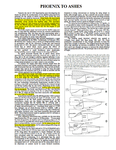Glider
Major
I admit this is an interesting thought. Its only a personal thought but the main difference I could think of is the change brought on by technology and the different skills needed.
For instance a modern fighter pilot can more or less do what they want with the controls, the computers will stop the aircraft doing anything dangerous and for a given control input, find the limit of performance for the pilot. An experienced pilot WW2 pilot will be more aware of the edge of the envelope and how to get that last bit of performance out of the design.
A modern pilot has very sophisticated head up display units, helmet dsiplays and audio warnings if anything is amiss. An experienced WW2 pilot would be more aware of what is going on inside the cockpit without spending a lot of time actually looking at the instruments. Scanning is a useful skill.
Keeping a lookout is also a skill. Everyone will agree that its as critical today as ever, but, there is no getting around that radar proximity warnings and other devices tend to ease the load. A ww2 pilot only had the eyes in their head and practice makes perfect.
In the early 70's trainee helicopter pilots at Culdrose were forbidden from joining the gliding club as what we taught, did in some way hinder their learning. To be honest I don't know what and we didn't expect it but it was an issue for the trainees.
As for tactics I doubt if they have changed much.
For instance a modern fighter pilot can more or less do what they want with the controls, the computers will stop the aircraft doing anything dangerous and for a given control input, find the limit of performance for the pilot. An experienced pilot WW2 pilot will be more aware of the edge of the envelope and how to get that last bit of performance out of the design.
A modern pilot has very sophisticated head up display units, helmet dsiplays and audio warnings if anything is amiss. An experienced WW2 pilot would be more aware of what is going on inside the cockpit without spending a lot of time actually looking at the instruments. Scanning is a useful skill.
Keeping a lookout is also a skill. Everyone will agree that its as critical today as ever, but, there is no getting around that radar proximity warnings and other devices tend to ease the load. A ww2 pilot only had the eyes in their head and practice makes perfect.
In the early 70's trainee helicopter pilots at Culdrose were forbidden from joining the gliding club as what we taught, did in some way hinder their learning. To be honest I don't know what and we didn't expect it but it was an issue for the trainees.
As for tactics I doubt if they have changed much.
Last edited:

